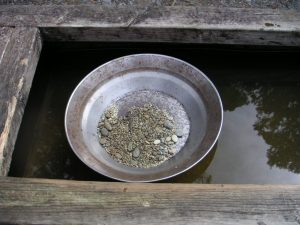By Jerrilynn Eby
Gold was discovered in Stafford during the eighteenth century. In 1787 Thomas Jefferson wrote in his Notes on Virginia, “I know a single instance of gold found in this state. It was interspersed in small specks through a lump of ore, of about four pounds in weight, which yielded seventeen pennyweights [1/20 ounce] of gold, of extraordinary ductility.” This gold was found in Stafford about four miles below Fredericksburg on the north side of the Rappahannock.
“Gold fever” struck the area around 1829. From then until 1900 gold was mined at several locations in the county. Hopeful gold-seekers ranged through Stafford, Orange, Culpeper, Fluvanna, Goochland, and Louisa Counties following the Rappahannock, Rapidan, and their tributaries. This gold belt extended from the Potomac to the James Rivers and was part of a larger deposit which extended through the Carolinas and into Georgia.
Panning was the most frequently used method of separating the precious metal from creek or river deposits. This method was later used by California prospectors. While primitive, panning in Stafford was successful enough to encourage other more elaborate methods of mining.
In Stafford, most of the gold mines were in the vicinity of present-day U.S. Route 17. Gold and graphite are present in the rock outcroppings of the Rappahannock River. Those deposits follow the river bed into Fauquier County. There were other gold mines in this part of the county, including Prospect Mine, Three Sisters Mine, New Hope, Monroe Mine, King Mine, Rattlesnake Mine, Horsepen Run Mine, Eliot Farm, and Wise Farm.
The old Eagle Mine near the Fauquier County line had its own stamping mill. The Eagle, like most local gold mines, was a shaft mine. Ore was dug from the hole and crushed. The gold was extracted from the rock and stamped into usable lumps. The machinery used at the Eagle operation was expensive, indicating the presence of high-quality ore. Unfortunately, shaft mines had a tendency to fill up with water. The pumping equipment didn’t work well, which made the extraction of ore unprofitable after the discovery of gold in California. Panning for small quantities of gold, however, continues today. The area known as Gold Vein was named because of mining operations there. Even after the Civil War, when the land had become poor from overwork and much of the population had moved west to Kentucky, land around the mines brought prices almost as high as today.
This writing originally appeared in They Called Stafford Home: The Development of Stafford County, Virginia, from 1600 until 1865, by Jerrilynn Eby, on pages 302-304, and appears here with the author’s permission


